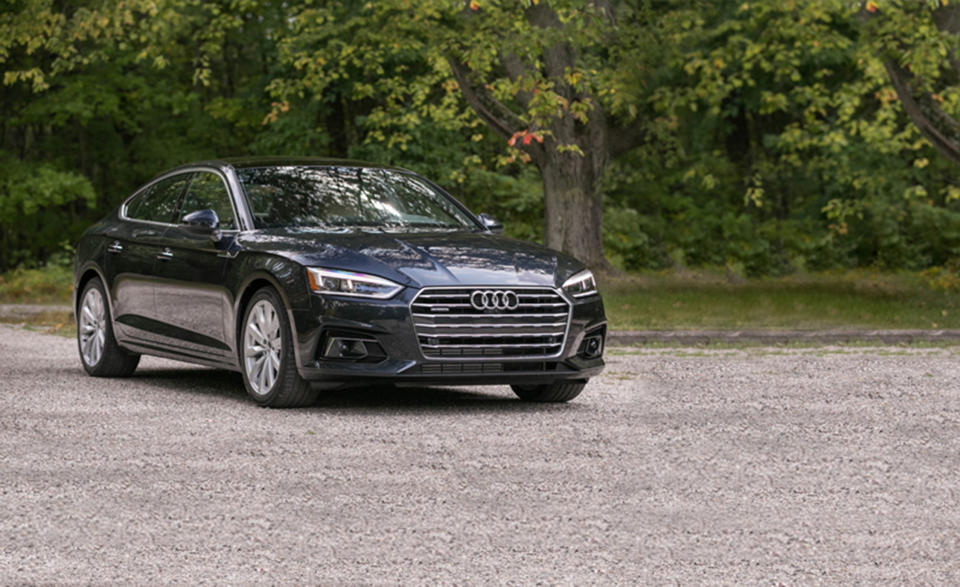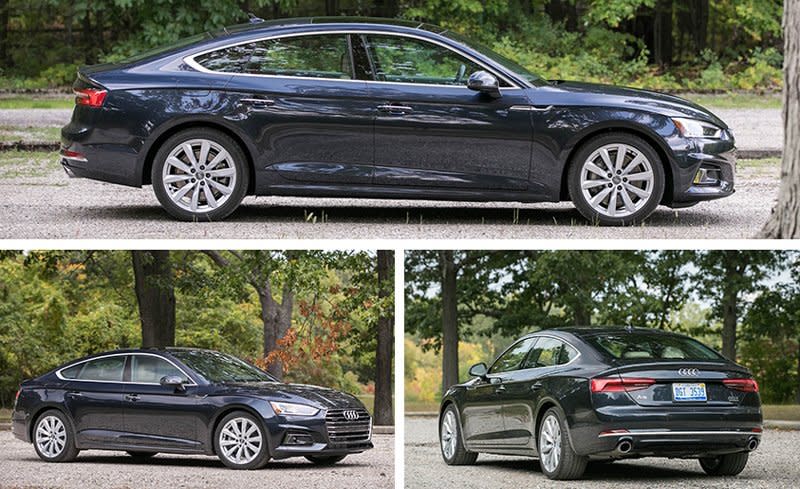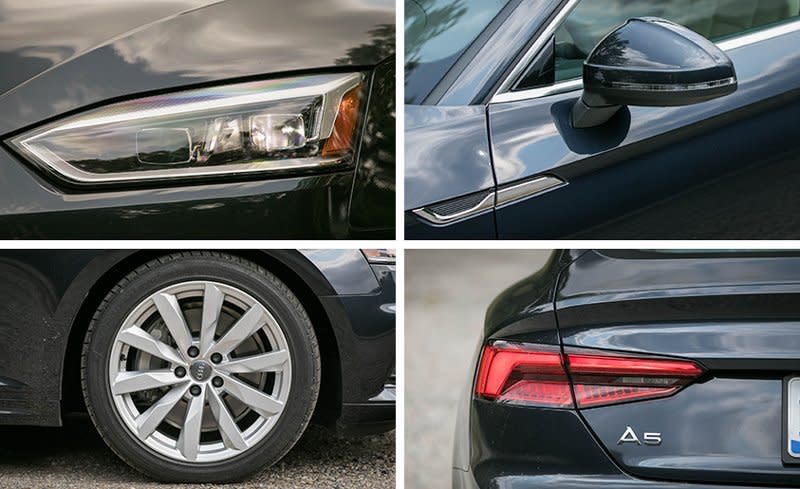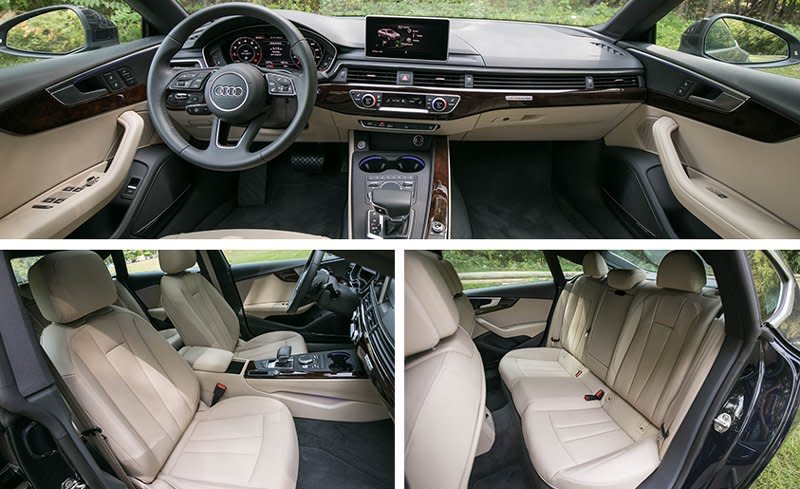2018 Audi A5 Sportback

One wonders what the Audi A5 Sportback does that the A4 sedan doesn’t do, aside from look prettier and haul more luggage at the expense of some back-seat space. But then you drive it, and it does so many things well. The turbocharged 2.0-liter inline-four is one of the best of its ilk, the chassis is buttoned down, the interior is well turned out, and the electronics are both modern-looking and easy to use.
Sportback is Audi’s euphemism for hatchback, at least as it is applied to the brand’s compact four-door. In the same way that the larger A7 hatchback is derived from the A6, the A5 Sportback is related to the A4 sedan. The success of the A7 doubtless emboldened Audi to send us the latest A5 Sportback after denying the U.S. market the previous-generation version.

The A7 also set the tone thematically for the A5 Sportback. That means a lower roofline (by 1.6 inches in this case) and sleeker styling with a faster-sloping backlight than you’d see on the A4, yet a lot more utility than you’d get in the two-door A5 coupe. Like the A7, the A5 Sportback also is pricier than its lower-numbered sedan sibling—the better to ward off any whiff of the economy-car hatchbacks that some shoppers might remember from the 1970s-era fuel crisis. The A5 Sportback is $2100 more expensive than its mechanically identical A4 counterpart, while the six-cylinder S5 commands a $3000 premium over the S4. (The gulf between A4 and A5 widens when you consider that the A4 is available in a lower-horsepower front-drive Ultra trim level that the A5 doesn’t bother with.)
To the A5 Sportback’s $43,575 base price, our test example added the top-spec Prestige trim-level package for $7600. Among its many niceties are heated eight-way power front seats, blind-spot monitoring, LED headlights, a Bang & Olufsen audio system, a top-view camera system, a head-up display, navigation, and Audi’s Virtual Cockpit digital instrument cluster. We were further assisted by the Driver Assistance package ($1800) with its adaptive cruise control, lane-keeping assist, traffic-sign recognition, and automatic high-beams. An adaptive suspension, heated rear seats, a heated steering wheel, high-gloss walnut trim, and Moonlight Blue Metallic paint brought the total to $55,400.

Turbo Fourtitude
These days, turbocharged 2.0-liter inline-fours are ubiquitous, but Volkswagen/Audi has had longer experience with this engine type than most, and it shows. There isn’t a flat spot in this engine’s powerband, a healthy 273 lb-ft of torque is on tap from 1600 rpm, and throttle response is measured and predictable. The engine is paired exclusively with a seven-speed S tronic dual-clutch automatic—unfortunately, the six-speed stick that can be had in the A4 and A5 coupe isn’t offered. The good news is that the dual-clutch transmission rarely guesses wrong. Despite the lack of a torque converter, the S tronic is generally smooth in low-speed operations—only once did we catch it fumbling in a light-throttle situation. We’re not fans of Audi’s gimmicky electronic gearshift, however; it doesn’t move through detents but only toggles forward and back, with park accessed via a push button.
Once underway, the 252-hp turbo four and dual-clutch ‘box make for robust acceleration. Sixty mph comes up in 5.3 seconds, and the quarter-mile passes in 14.0 seconds at 100 mph. Those times are exactly 0.1 second behind our figures for the 87-pound-lighter A4 sedan with this same powertrain. It’s also not terribly far off the V-6–powered S5 Sportback we recently tested, which has an additional 102 horsepower on tap and another 96 lb-ft of torque—that model reaches 60 in 4.3 seconds and blasts through the quarter-mile in 12.9 at 108 mph. More to the point, the A5 Sportback outhustled the last BMW 428i Gran Coupe we tested (a rear-driver) by 0.2 second to 60 and also by two ticks in the quarter-mile.

Our A5 Sportback was equipped with Audi’s adaptive air-spring suspension ($1000), which includes selectable driving modes. Rolling on 18-inch wheels with 40-series tires, it doesn’t have a harsh ride, but there’s room for improvement in its ability to mask disturbances at highway speeds, which are acknowledged with a short kick and sometimes accompanied by a brief lateral body motion (even with the drive-mode selector in Comfort). On smooth freeways, we also encountered some small-amplitude body motions—up and down as well as lateral—that made the A5’s tracking something short of laserlike. The various modes do little to affect chassis response, although Dynamic adds a welcome measure of tautness to the steering without unduly raising efforts. It’s the ideal choice for curvy roads, which the A5 tackles with aplomb despite its nose-heavy layout. The standard all-wheel-drive system defaults to a 60 percent rear torque bias, but it constantly varies the flow between front and rear wheels as conditions dictate. The A5 exhibited plenty of stick on our skidpad (0.94 g), besting the A4 (0.90) and the 428i (0.89). Braking also was impressive, with the Sportback coming to a halt from 70 mph in 159 feet and the pedal both firm and easy to modulate.
Screen Scene
The interior isn’t flashy—well, apart from the screen-based, configurable instrument cluster—but the materials are all of high quality. The MMI controller with its drawing recognition is surprisingly useful for entering addresses or finding contacts, and the system’s predictive logic is sharp enough that you rarely have to spell out the whole thing. This isn’t an interior where extreme aesthetics banish all buttons, and it’s the better for it. Audi’s combination of click-wheel controller, physical buttons, touchpad, and steering-wheel controls is nicely realized. And shout out to the front seats, which are firm but nicely sculpted, offering decent lateral support without being confining.
The Sportback’s squashed roofline does constrict the view out—the backup camera is essential—and it also makes for a more confining rear seat than in the sedan, to the point that this a marginal conveyance for four adults on a long trip. The upside is the hatchback’s more generous cargo room: 22 cubic feet behind the rear seats, 35 with the rear seatbacks folded. (The A4 sedan and A5 coupe have just 13 and 12 cubic feet in their trunks, respectively.) It also scores some serious junior-A7 style points. Overall, this is an extremely well-executed premium four-door with the added flair and function of a shapely hatchback body style. But it’s best enjoyed by two rather than four.
Specifications >
VEHICLE TYPE: front-engine, all-wheel-drive, 5-passenger, 4-door hatchback
PRICE AS TESTED: $55,400 (base price: $43,575)
ENGINE TYPE: turbocharged and intercooled DOHC 16-valve inline-4, iron block and aluminum head, direct fuel injection
Displacement: 121 cu in, 1984 cc
Power: 252 hp @ 6000 rpm
Torque: 273 lb-ft @ 1600 rpm
TRANSMISSION: 7-speed dual-clutch automatic with manual shifting mode
DIMENSIONS:
Wheelbase: 111.2 in
Length: 186.3 in
Width: 72.6 in Height: 54.6 in
Passenger volume: 93 cu ft
Cargo volume: 22 cu ft
Curb weight: 3758 lb
C/D TEST RESULTS:
Zero to 60 mph: 5.3 sec
Zero to 100 mph: 14.0 sec
Zero to 120 mph: 22.1 sec
Rolling start, 5–60 mph: 6.1 sec
Top gear, 30–50 mph: 3.1 sec
Top gear, 50–70 mph: 3.9 sec
Standing ¼-mile: 14.0 sec @ 100 mph
Top speed (governor limited): 129 mph
Braking, 70–0 mph: 159 ft
Roadholding, 300-ft-dia skidpad: 0.94 g
C/D FUEL ECONOMY:
75-mph highway driving: 34 mpg
Highway range: 520 miles
EPA FUEL ECONOMY:
Combined/city/highway: 27/24/34 mpg

 Yahoo Autos
Yahoo Autos 